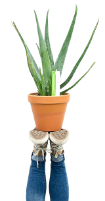Which palm fits where?
When you buy a palm, you want to be sure it will thrive in the spot you have chosen for it. To assist you, we have compiled a list. This list shows palms suitable for various conditions. In the list below, you can easily scroll through the page to find what you're looking for.
Note: We do not carry all palms in our assortment; this list is purely for information.
Contents:
- Drought resistant
- Water-loving
- Fast-growing
- Slow-growing
- Ground-covering palms
- Hedge palms
- Large palms
- Small palms
- Salt-resistant palms
- Palms with coloured leaves
Drought-Resistant Palms
No palm is as drought-resistant as many cacti, but there are enough that can handle some drought. These palms can often go longer without water and can withstand dry winds. However, they must receive sufficient water when they are watered – they ultimately need just as much water but can better handle longer periods without.
Bismarckia nobilis (fair)
Brahea armata (fair)
Brahea brandegeei (fair)
Brahea decumbens (good)
Butia archeri (good)
Butia capitata (fair)
Butia eriospatha (fair)
Butia yatay (fair)
Chamaerops humilis (good)
Chamaerops humilis Cerifera (very good)
Chamaerops humilis Vulcano (good)
Copernica alba (fair)
Dypsis decaryi (good)
Dypsis decipiens (good)
Jubaea chilensis (good, but only once well-established)
Latania (fair)
Livistona chinensis (fair)
Livistona mariae (fair)
Livistona muelleri (fair)
Livistona nitida (fair)
Nannorrhops (very good)
Phoenix canariensis (good, but only once established)
Phoenix dactylifera (good, but only once established)
Phoenix loureiri (light)
Phoenix sylvestris (good, but only once established)
Phoenix theophrasti (good, but only once established)
Pseudophoenix (good)
Sabal bermudana (fair)
Sabal domingensis (fair)
Sabal mauritiiformis (fair, but only once established)
Sabal mexicana (good, but only once established)
Sabal palmetto (fair)
Sabal rosei (good)
Sabal texana (good, but only once established)
Sabal uresana (good)
Sabal yapa (fair)
Trithrinax (good)
Water-Loving Palms
Not all palms thrive in drier conditions. Palms are known for the amount of water they can drink. In contrast to the palms mentioned above, the palms below actually prefer extra water.
Acoelorraphe
Euterpe
Livistona australis
Livistona benthamii
Livistona decipiens
Phoenix roebelenii
Ptychosperma macarthurii
Ravenea rivularis
Rhapidophyllum hystrix
Roystonea regia
Washingtonia robusta
Fast-Growing Palms
Each palm has its own growth rate, often differing from one palm to another. Several factors, such as nutrition, water, and location, can affect a palm's growth rate. Nonetheless, palms can be categorized by growth speed. Below is a selection of palms that grow faster than average.
Archontophoenix alexandrae (moderately faster)
Archontophoenix cunninghamiana (moderately faster)
Caryota (slightly faster)
Chambeyronia macrocarpa (moderately faster)
Copernica alba (slightly faster)
Dypsis lutescens (moderately faster)
Euterpe edulis (moderately faster)
Hyophorbe indica (slightly faster)
Livistona chinensis (moderately faster)
Livistona decipiens (moderately to much faster)
Livistona nitida (moderately faster)
Phoenix canariensis (slightly faster)
Phoenix dactylifera (slightly faster)
Phoenix reclinata (slightly faster)
Phoenix roebelenii (slightly faster)
Phoenix rupicola (slightly faster)
Phoenix sylvestris (slightly faster)
Ptychosperma elegans (slightly faster)
Ptychosperma macarthurii (slightly faster)
Ravenea rivularis (slightly faster)
Roystonea regia (moderately faster)
Syagrus romanzoffiana (much faster)
Trachycarpus fortunei (slightly faster)
Trachycarpus wagnerianus (slightly faster)
Washingtonia robusta (much faster)
Wodyetia (slightly faster)
Slow-Growing Palms
Unlike the palms above, the following palms grow slower than average.
Coccothrinax
Jubaea chilensis
Livistona muelleri
Lytocaryum weddellianum
Parajubaea
Phoenix loureiri
Pinanga veitchii
Pritchardia hillebrandii
Pseudophoenix
Rhapidophyllum hystrix
Trithrinax campestris
Ground-Covering Palms
The palms below are low-growing palms that primarily "creep" across the ground. This makes them unique ground covers. Some of these can be placed in groups.
Arenga hookeriana
Brahea decumbens
Chamaedorea adscendens
Chamaedorea brachypoda
Chamaedorea cataractarum
Chamaedorea elegans
Chamaedorea metallica
Chamaedorea nubium
Chamaedorea elegans
Chamaedorea radicalis
Pinanga pilosa
Pinanga polymorpha
Rhapis laosensis
Hedge Palms
To plant a hedge, you need a plant that is full of foliage from top to bottom. The palms listed below meet this requirement and can be used as hedge plants or for screening.
Acoelorraphe
Allagoptera
Arenga australasica
Arenga engleri
Brahea decumbens
Caryota mitis
Chamaedorea cataractarum
Chamaedorea microspadix
Chamaedorea seifrizii
Chamaerops
Dypsis lutescens
Nannorrhops
Pinanga coronata (kuhlii)
Rhapidophyllum
Rhapis excelsa
Rhapis humilis
Trithrinax campestris
Large Palms
The palms listed below are species that generally grow very large. These are palms that grow taller than 15 meters or are otherwise large in proportions. Keep in mind that factors such as climate, location, and nutrition can influence this.
Bismarckia nobilis
Caryota gigas
Caryota maxima
Copernica alba
Jubaea chilensis
Kentiopsis oliviformis
Livistona australis
Livistona nitida
Phoenix canariensis
Phoenix dactylifera
Phoenix reclinata
Phoenix sylvestris
Ravenea rivularis
Roystonea regia
Veitchia joannis
Small Palms
Below is a list of palms that generally remain smaller than 3 meters in height and are not large in width.
Allagoptera
Arenga hookeriana
Brahea decumbens
Brahea moorei
Butia archeri
Chamaedorea (many species)
Phoenix loureiri
Phoenix roebelenii
Pinanga (many species)
Rhapidophyllum
Rhapis excelsa
Sabal minor
Syagrus schizophylla
Trachycarpus nanus
Salt-Resistant Palms
Many palms can tolerate salty soil or salty air to some degree. These palms are better suited for coastal areas.
Acoelorraphe (fair)
Allagoptera (very high)
Chamaerops humilis (fair)
Chamaerops humilis Cerifera (fair)
Chamaerops humilis Vulcano (fair)
Hyophorbe lagenicaulis (fair)
Hyophorbe verschaffeltii (fair)
Livistona benthamii (fair)
Livistona chinensis (fair)
Nannorrhops (fair)
Phoenix canariensis (only salty air)
Phoenix dactylifera (good)
Phoenix loureiri (fair)
Phoenix sylvestris (light)
Phoenix theophrasti (very good)
Pseudophoenix sargentii (very good)
Sabal bermudana (fair)
Sabal domingensis (fair)
Sabal gretheriae (fair)
Sabal mauritiiformis (light)
Sabal mexicana (fair)
Sabal palmetto (fair)
Sabal rosei (fair)
Sabal texana (fair)
Sabal uresana (fair)
Sabal yapa (fair)
Syagrus schizophylla (fair)
Veitchia (only salty air)
Washingtonia robusta (fair)
Palms with Coloured Leaves
The following species are known for their unique coloured appearance. They have coloured leaves. Sometimes this is only with new leaves, while others have this permanently.
Bismarckia nobilis
Brahea armata
Brahea decumbens
Brahea sp. Super Silver
Chambeyronia macrocarpa (young leaves)
Coccothrinax
Copernica alba (depending on the soil)
Latania loddigesii
Latania lontaroides
Latania verschaffeltii
Pinanga coronata (kuhlii)
Sabal uresana
Serenoa repens (sometimes)
Back to the top of this page.
